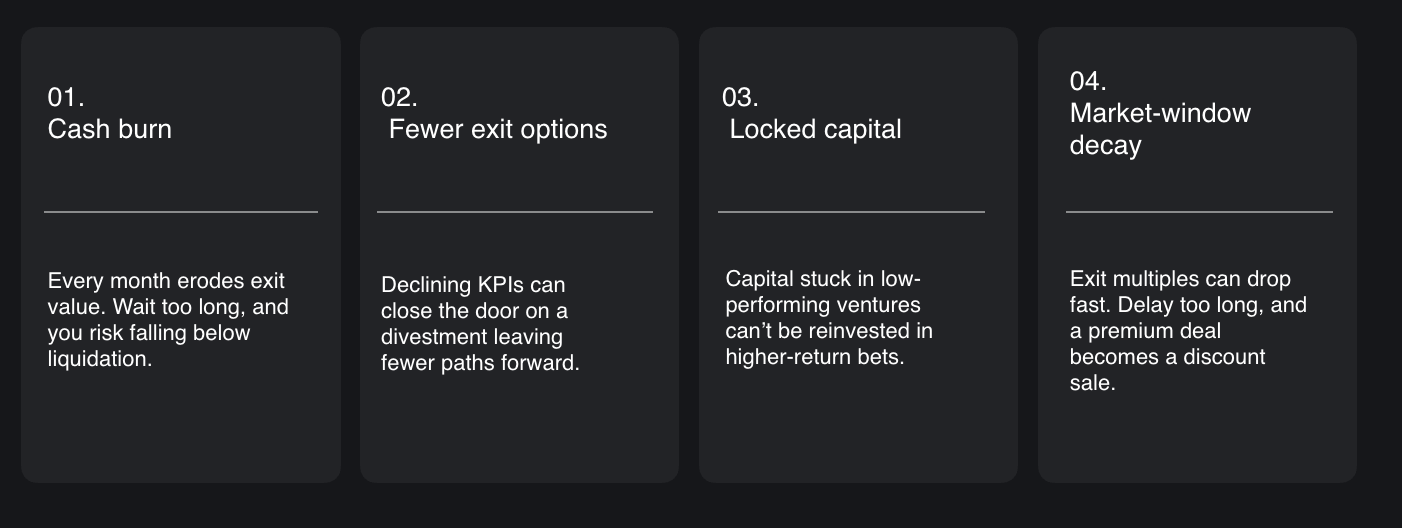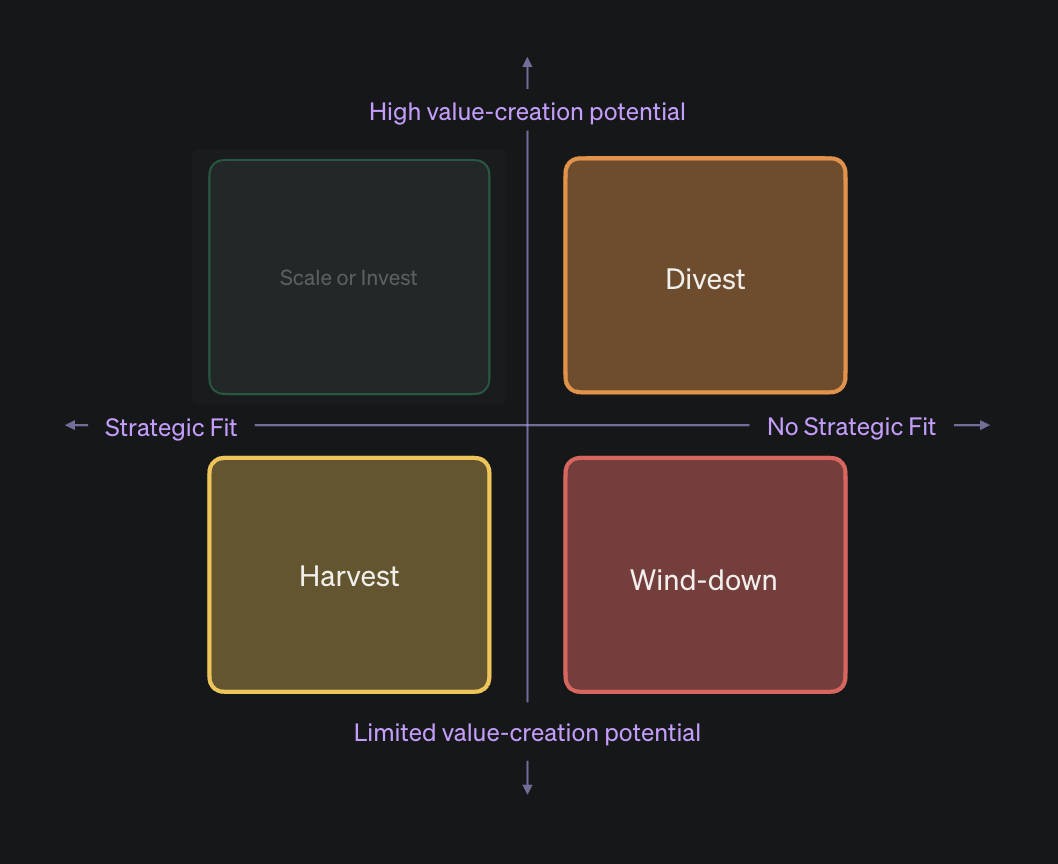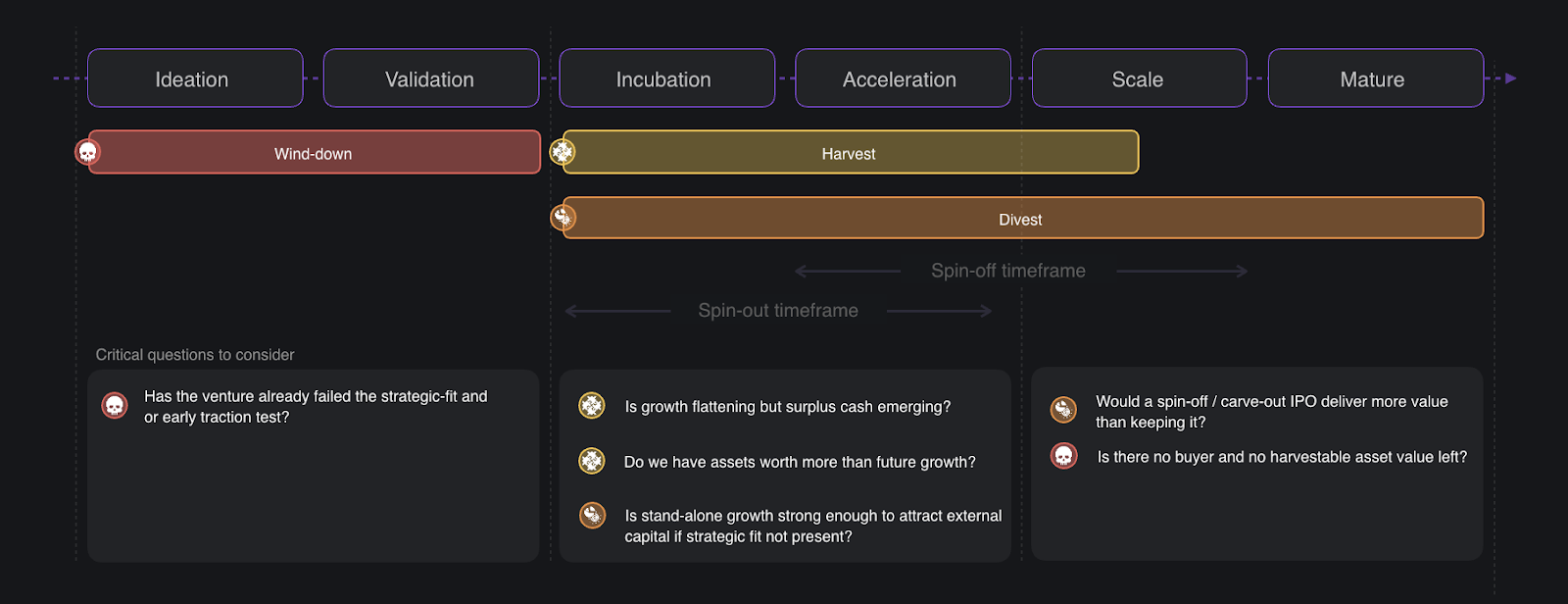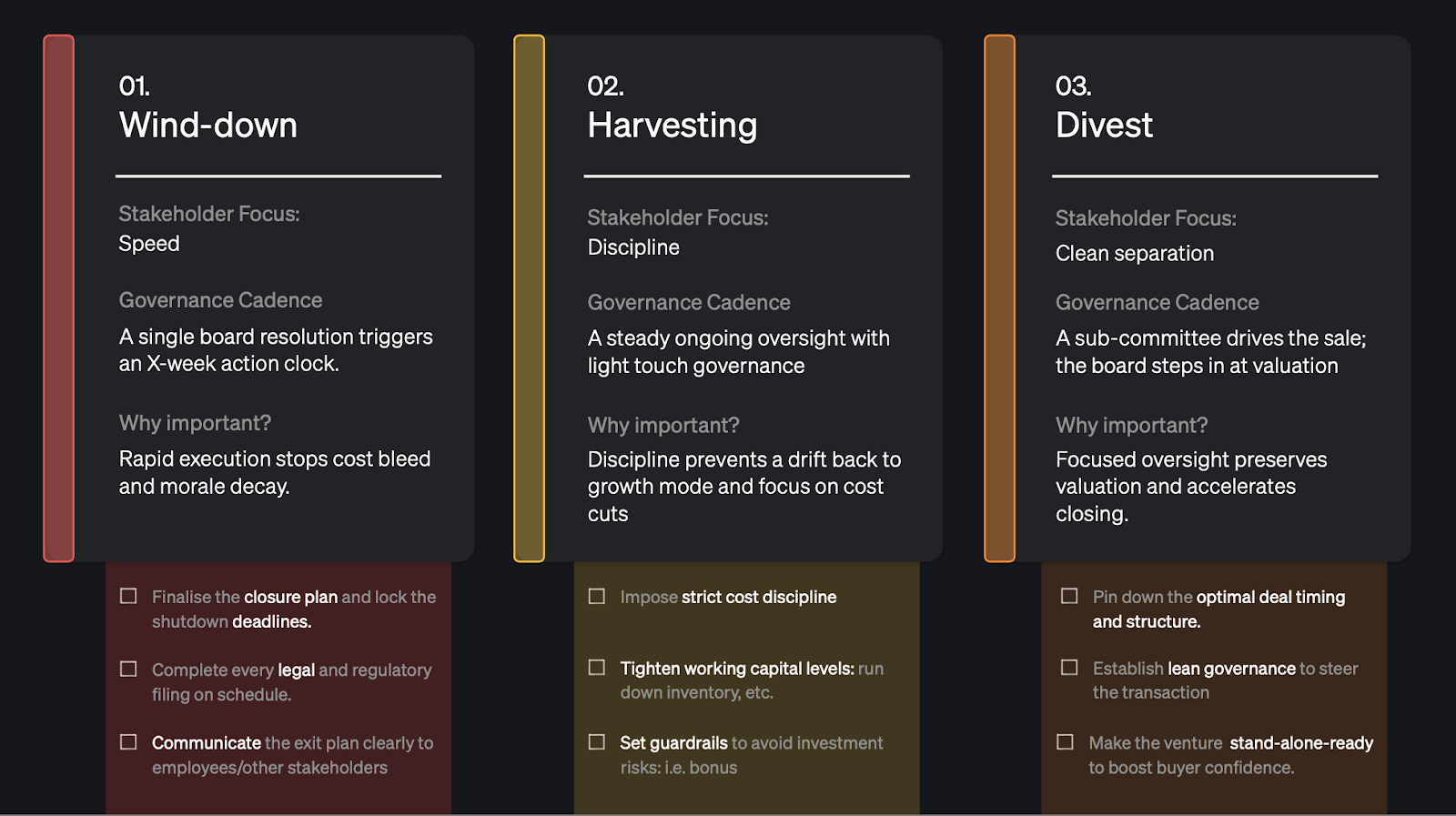


Corporate venture exits are often an afterthought. Some are shut down too fast, leaving value behind. Others limp along, burning cash and blocking better bets. Either way, the outcome is the same: wasted resources and missed opportunities.
The good news? When executed correctly, an exit can become a power move that enables you to preserve value, unlock capital and focus your venturing efforts.
At our last Bundl Venture Club roundtable, we caught up with senior corporate innovators from DB Schenker, A2A, Henkel, Saint-Gobain and more to unpack what smart venture exits really look like and how to get them right, including:
- How to choose the right exit path based on venture maturity and value
- How to preserve value through harvests, divestments, or structured shutdowns
- How to manage board alignment, investor expectations, and founder trust
We’re sharing their real-world tools, frameworks and proven strategies so you can tackle your next exit with clarity and confidence.
Let’s dive in.
Q: What is an exit strategy in corporate innovation?
A: An exit strategy is a predefined plan for how a corporate venture will be shut down, sold, or spun out. It helps teams manage risk, protect capital, and make space for better opportunities.
“If you don’t define clear exit paths from the start, you limit future options—especially when priorities change or the corporate needs to step back.”
— Tobias Ledermann, DB Schenker, Bundl Venture Club member
Q: Should you define exit options at the start of the venture?
A: Yes. Predefining exit paths like spinout clauses or management buyout options, makes transitions smoother and faster. It also builds trust with founders and gives your venture team clarity on what happens if priorities shift down the line.
Q: When is the right time to exit a venture?
A: The right time to exit is when the venture is no longer on track to deliver meaningful value and the cost of continuing outweighs the potential upside. For example:
- The venture has low value and no strategic fit
- It’s not scalable, but still holds assets you can harvest
- It has market potential, but no longer aligns with your strategy
The decision should be based on clear evidence and metrics, not instinct, politics, or sunk cost.
Q: What happens if you wait too long to make an exit call?
A: Waiting can feel safe, but it quietly racks up hidden costs. Exit options shrink fast when a venture loses momentum. Every extra month increases risks across four areas: cash burn, optionality, capital efficiency, and market timing.

The result? Zombie or living dead ventures.
Q: What is a zombie or living dead venture?
A: It’s a venture that isn’t growing, scaling, or delivering strategic value, but also hasn’t been formally shut down. It’s stuck in limbo: not successful enough to invest in, not weak enough to kill.
These ventures often continue to burn resources, distract teams, and block capital that could be redeployed elsewhere. Without a clear decision, they quietly drain value over time.
Q: What’s the role of legal and IP planning in corporate venture exits?
A: It’s critical. If you’re spinning out a venture or selling it off, you’ll need clean IP ownership, license agreements, and governance structures. These things are hard to fix retroactively, so it’s best to plan for them early.
“If you want your venture to be investable or spun out later, you need to get the legal and IP setup right from the start. It’s hard to fix that after the fact.”
— Laura Rosseel, Cambrian, Bundl Venture Club member
Q: What are the exit paths for corporate ventures?
A: Corporate venture exits typically fall into three strategic categories, each tailored to the venture’s maturity, performance, and strategic relevance:
- Wind-down: A controlled closure used when the venture no longer holds strategic value and lacks viable acquisition interest.
- Harvest: A value-extraction approach suited for ventures with limited growth potential but remaining internal assets (e.g. proprietary technology, IP, or talent).
- Divest: A strategic exit through sale or spinout when the venture holds external value but no longer fits the corporate agenda.
Q: How do I know which exit path best fits my venture?
A: Start by evaluating two key factors:
- Strategic fit: Does the venture still align with your company’s long-term priorities?
- Value potential: Can the venture deliver returns, either internally or externally?
Then use the Exit Strategies Matrix to guide your decision:
- Wind-down: Use when the venture has low value and no strategic fit.
- Harvest: Use when the venture isn’t scalable but still holds valuable assets.
- Divest: Use when the venture has external market value but no longer fits your strategy.

Q: Does venture maturity impact the exit path?
A: Yes, timing matters. As a venture progresses through its lifecycle, different exit paths become more relevant. For example:
- Wind-down fits early stages (ideation, validation) if traction is low or the fit is missing
- Harvest fits mid-stage (incubation, acceleration) when growth stalls, but assets still hold value
- Divest fits later stages (scale, mature) when the venture is viable but no longer aligned with corporate strategy
Pressure test your ventures at each stage of the lifecycle to ensure you choose the right path forward and maximise value.

Q: What strategies can I use to wind down, harvest, or divest?
A: Each exit path comes with specific strategies. Here’s a breakdown:
Wind-down:
- Formal closure: dissolve the entity, settle contracts and debts
- Silent sunset: freeze hiring/marketing so it fades quietly
- Transparent sunset: announce exit, share learnings
- “Zombie” hold: keep the shell alive only to protect licences/IP
- Fold‑in: absorb useful tech or staff, then dissolve
Harvest
- License IP or data
- Sell brand, equipment, or contracts
- Redeploy team members internally
- Collect receivables and run down inventory
- Monetise or migrate customers
Divest
- Strategic sale
- Financial sale to a PE or secondary investor
- Spin-out or carve-out IPO (retain ≤ 20% stake)
- Management or founder buyout
- Discounted exit to reduce internal distraction
- Management or founder buyout
- Discounted exit to reduce internal distraction
Q: What are the pros and cons of winding down, harvesting and divesting?
A: Each exit path comes with its own trade-offs. Wind-downs are fast and clean but often result in a full write-off. Harvesting allows you to recover some value, but it requires time, focus, and operational discipline. Divesting can deliver the highest return, but it’s complex, resource-intensive, and requires alignment across multiple stakeholders.
Q: Can you harvest value from a minority stake in a venture? If so, how?
A: Yes, but it’s rarely straightforward. As a minority shareholder, you can’t act alone; you’ll need alignment from the board and majority stakeholders to move forward.
If there’s consensus to exit or wind down, common value-harvesting options include:
- Licensing or selling IP
- Selling specific assets (e.g. tech, contracts, brand)
- Supporting an acqui-hire or partial team transfer
Without board-level buy-in, these actions are difficult to initiate. The key is early engagement, clear incentives, and positioning the exit as a win for all parties involved.
“As a minority shareholder, you can’t move alone. Harvesting only works if the board and majority owners are aligned.”
— Laura Rosseel, Cambrian, Bundl Venture Club member
Q: What’s the best way to preserve value when winding down a venture?
A: The key is to act early, before the venture loses all momentum. You’ll recover more by selling assets, licensing IP, or facilitating an acqui-hire before it reaches formal closure.
It also helps to frame the exit as a positive story (e.g. “X acquired Y”) to protect your brand and the team’s reputation. A well-managed wind-down can still create value—it just requires proactive planning.
Q: How does corporate ownership impact investor interest during a divestment?
A: Corporate ownership can make or break investor interest. When corporates retain majority stakes or blocking rights, it raises concerns about control, agility, and long-term upside, especially for VCs and private equity.
To attract external buyers or funding, use investor-friendly terms like:
- Minority corporate ownership
- No special veto rights
- Independent governance and decision-making
The more autonomy the venture has, the more likely it is to succeed outside the corporate parent.
Q: How do you get internal stakeholders on board when exiting a venture?
A: Keep it simple. Stakeholders want clear logic and low-effort decisions. Present them with a clear path: the rationale, the upside, and how you’ll do it with minimal disruption.
Quick-win proposals are more likely to get buy-in than complex or open-ended strategies.
Q: Do you need internal alignment to execute a wind-down, harvest or divestment?
Yes. Each exit path requires a different focus, governance cadence, and level of board alignment. Here’s a quick breakdown:

Q: Can you exit a venture and still retain a stake in its future value?
Yes. Many corporates keep a small passive equity stake (usually under 20%) in divested ventures. Others license the IP back or maintain brand rights. You can also hold the legal entity in “zombie mode” to preserve dormant value or relaunch later.
Q: How do you build in optionality without scaring away founders or investors?
Be transparent. Let founders know that if the corporate loses strategic interest, there’s a clear process for spinning out or buying the venture. Avoid heavy-handed control that could limit outside investment or kill the venture’s growth potential.
“You need to be transparent from day one. If founders don’t see a clear path in case the corporate steps back, they won’t sign up, and investors won’t either.”
— Tobias Ledermann, DB Schenker, Bundl Venture Club member
Final thoughts
The most effective innovators treat exits as part of the strategy, not an emergency response. They plan early, act with discipline, and make room for what’s next before value is lost.
The result? Smart exits that protect capital, preserve reputation, and clear the runway for stronger bets.
—
Looking for more corporate venturing insights, by innovators, for innovators? Join 300+ senior innovation leaders at Bundl Venture Club to explore real venture cases, proven frameworks, and live session insights to help you make better calls, faster. It’s free.


.webp)







.svg)

.webp)



